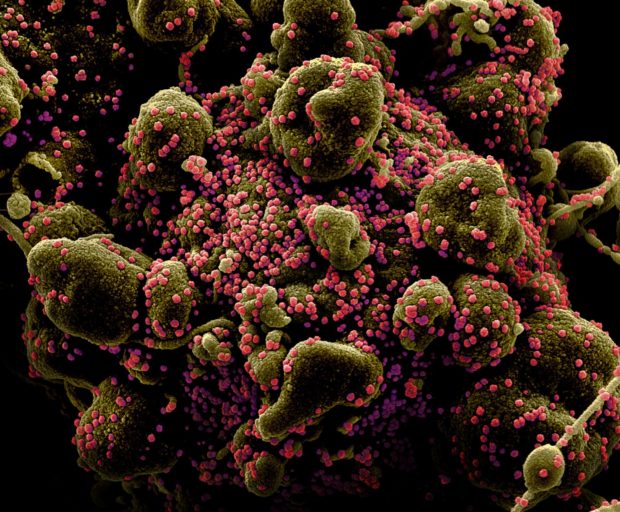
FILE PHOTO: Colorized scanning electron micrograph of an apoptotic cell (greenish brown) heavily infected with SARS-COV-2 virus particles (pink), also known as novel coronavirus, isolated from a patient sample. Image captured and color-enhanced at the NIAID Integrated Research Facility (IRF) in Fort Detrick, Maryland. National Institute of Allergy and Infectious Diseases, NIH/Handout via REUTERS.
MANILA, Philippines — The COVID-19 variant first detected in India is now here in the Philippines.
Health Undersecretary Maria Rosario Vergeire said in an online press briefing on Tuesday that the B.1.617 variant was detected from two individuals in the Philippines following genome sequencing.
Dr. Alethea De Guzman, director of the Department of Health’s (DOH) Epidemiology Bureau, also said in a press briefing that the two positive samples taken from returning overseas Filipinos (ROFs) were among the 46 specimens that went through the latest run of genome sequencing.
Among the 46 samples, 23 were also found positive for the B.1.351 variant first detected in South Africa and four were positive for the B.1.1.7 variant first detected in the United Kingdom.
De Guzman said one of the ROFs is a 37-year-old sea-based overseas Filipino worker (OFW) currently in Soccsksargen. He arrived in the Philippines from Oman on April 10. His specimen was collected for testing on April 15.
He was isolated in a hotel in Metro Manila upon arrival and recovered on April 26. He went through additional home quarantine in Soccsksargen until May 10. His repeat RT-PCR test was conducted on May 3, where he tested negative for the virus.
“The case is already well and remained asymptomatic,” said De Guzman.
Meanwhile, the second ROF is a 58-year-old sea-based OFW currently in Bicol Region.
De Guzman said he arrived in the Philippines from the United Arab Emirates on April 29. His samples were collected on April 24.
She added that the patient was isolated in a temporary treatment and monitoring facility in Clark and was declared recovered on May 6.
According to De Guzman, there was no close contact identified for the two cases since they were immediately quarantined upon arrival to the country. She also said that available information shows that some of the plane passengers near the two travelers have already tested negative for the virus and that authorities are only trying to confirm if they have already completed their quarantine.
Vergeire clarified that the variant cases did not have travel history from India and that their samples were only subjected to genome sequencing that included specimens from ROFs.
Meanwhile, of the five individuals with travel history from India, only one has been sequenced and was found to have the A lineage, which is “not a variant of concern nor a variant of investigation.” The three were not eligible for sequencing because of high cycle threshold value, while the other one is up for sequencing, said Vergeire.
Health authorities earlier said the B.1.617 variant currently being investigated was found to have 15 mutations, including the E484Q and L452R.
Experts say that the E484Q mutation is similar to the E484K called the “escape mutation” that helps the virus get past the body’s immune system, while L452R was found by a Californian study to be an efficient spreader of the virus.
According to De Guzman, the version of the variant from India that was detected from the two ROFs was the B.1.617.2, which also contains the T478K mutation located on the SARS-CoV-2 spike protein.
RELATED STORY:
Variant accelerating India’s COVID explosion: WHO top scientist